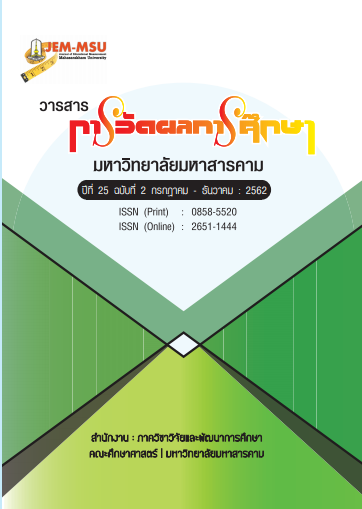Using Lesson Study Guidelines to Promote Scientific Conceptual Understanding
Main Article Content
Abstract
The objectives of this research were to 1) study the scientific conceptual understanding of the students who learned with preservice teachers who had learned by using lesson study guidelines, and 2) study the scientific conceptual understanding of the students who learned with preservice teachers who had learned without the lesson study guidelines. The sample consisted of 6 fifth year preservice teachers in the General Science Program of the Bachelor of Education curriculum, obtained through purposive sampling; and students in science classes taught by the aforementioned preservice teachers, of whom 150 were grade 5 and grade 6 students from Anuban Roiet School and 144 were grade 8 and grade 9 students from Wapipathum School. The research instruments were: lesson study guidelines, an objective multiple-choice test on scientific conceptual understanding with a rational explanation, and a focus-group discussion. The qualitative data analysis employed content analysis while the quantitative data analysis employed percentage and the mean.
The research findings were as follows:
1. The scientific conceptual understanding of the students who learned with the preservice teachers who had learned by using the lesson study guidelines had an increasing tendency of scientific concepts.
2. The scientific conceptual understanding of the students who learned with the preservice teachers who learned without the lesson study guidelines had no distinctive increasing tendency of scientific concepts.
Article Details
The content and information contained in the published article in the Journal of Educational Measurement Mahasarakham University represent the opinions and responsibilities of the authors directly. The editorial board of the journal is not necessarily in agreement with or responsible for any of the content.
The articles, data, content, images, etc. that have been published in the Journal of Educational Measurement Mahasarakham University are copyrighted by the journal. If any individual or organization wishes to reproduce or perform any actions involving the entirety or any part of the content, they must obtain written permission from the Journal of Educational Measurement Mahasarakham University.
References
กัญญารัตน์ โคจร. (2559). การศึกษาผ่านบทเรียน: กลยุทธ์การส่งเสริมความสามารถในการคิดอย่างมีวิจารณญาณของนิสิตครู. วารสารศึกษาศาสตร์ มหาวิทยาลัยนเรศวร, 18(1), 218-229.
___________. (2560). การส่งเสริมความสามารถในการคิดอย่างมีวิจารณญาณและการแก้ปัญหาแบบ ร่วมมือของนิสิตครูด้วยการศึกษาผ่านบทเรียน. วารสารวิชาการ Veridian E – Journal, ฉบับภาษาไทย สาขามนุษยศาสตร์สังคมศาสตร์และศิลปะ, 10(3), 170-185.
ชาตรี ฝ่ายคำตา. (2551). แนวคิดทางเลือกของนักเรียนในวิชาเคมี. วารสารศึกษาศาสตร มหาวิทยาลัย
สงขลานครินทร์ วิทยาเขตปัตตานี, 19(2), 10-25.
ณัฏฐ์นภันต์ กตัญรัตน์ และสุวัตร นานันท์. (2558). การศึกษามโนมติทางวิทยาศาสตร์และความสามารถในการ สร้างแบบจำลองทางวิทยาศาสตร์โดยใช้การจัดการเรียนรู้แบบ MIS เรื่อง ไฟฟ้าเคมีของนักเรียนชั้น มัธยมศึกษาปีที่ 5. วารสารวิจัย มข. (ฉบับบัณฑิตศึกษา), 13(1), 82-92.
นฤมล อินทร์ประสิทธิ์. (2552). การศึกษาชั้นเรียน (Lesson Study): นวัตกรรมเพื่อการปฏิรูปครู. วารสาร ศึกษาศาสตร์ มหาวิทยาลัยขอนแก่น , 32(2), 12-21.
ธิดารัตน์ คำแพง, กัญญารัตน์ โคจร และ สุจินต์ อังกุราวิรุทธ์. (2560). การพัฒนาความเข้าใจมโนทัศน์ของ นักเรียนชั้นมัธยมศึกษาปีที่ 4 ตามทฤษฎีการเรียนรู้ของ Kolb โดยยึดรูปแบบวงจรการเรียนรู้ TSOI.วารสารวิชาการ Veridian E – Journal, ฉบับภาษาไทย สาขามนุษยศาสตร์ สังคมศาสตร์ และศิลปะ. 10(3). 567-584.
พิมพันธ์ วงษ์แก้ว. (2555). การเปลี่ยนแปลงความเข้าใจมโนมติ เรื่อง พันธะโคเวเลนต์ ของนักเรียนชั้นมัธยมศึกษาปีที่ 4 โดยใช้ยุทธศาสตร์การสอนเพื่อเปลี่ยนมโนมติ. วิทยานิพนธ์ปริญญาศึกษาศาสตร มหาบัณฑิต สาขาวิทยาศาสตร์ศึกษา คณะศึกษาศาสตร์ มหาวิทยาลัยขอนแก่น.
ภพ เลาหไพบูลย์. (2537). การสอนวิทยาศาสตร์ในโรงเรียนมัธยมศึกษา. เชียงใหม่: เชียงใหม่คอมเมอเชียล.
สถาบันทดสอบทางการศึกษาแห่งชาติ(องค์การมหาชน) . (2561). รายงานผลการทดสอบทางการศึกษา ระดับชาติขั้นพื้นฐาน (O-NET) ชั้นประถมศึกษาปีที่ 6. เข้าถึงได้จาก http//www.niets.or.th.
_________. (2561). รายงานผลการทดสอบทางการศึกษาระดับชาติขั้นพื้นฐาน (O-NET) ชั้นมัธยมศึกษาปีที่ 3. เข้าถึงได้จาก http//www.niets.or.th.
สถาบันส่งเสริมการสอนวิทยาศาสตร์และเทคโนโลยี (สสวท.). (2560), สรุปข้อมูลเบื้องต้น PISA 2015, กรุงเทพฯ: สถาบันส่งเสริมการสอนวิทยาศาสตร์และเทคโนโลยี.
Aydeniz, M., Pabuccu, A., Cetin, P.S. and Kaya, E. (2012). Argumentation and students’ conceptual understanding of properties and behaviors of gases. International Journal of Science and Mathematics Education, 10(6), 1303–1324.
Kanyarat, C. & Kanyarat, S. (2016). A Guideline of using Lesson Study for Preservice Science Teachers Thailand. Proceeding of the Asian Conference on Education & International Development 2016. April 3-6, 2016, Art Center Kobe, Japan, The International Academic Forum. 305-314.
Leonor Aguilar Lawlor. (2012). The Impact of Lesson Study on Intermediate Teachers' Abilities to Teach Critical Thinking, Develop Professionally, and Gain Efficacy. A Dissertation Presented in Partial Fulfillment of the Requirements for the Degree Doctor of Education. Arizona State University, USA.
Shulman, L. S. (1986). Those who understand: Knowledge growth in teaching. Educational Researcher, 15(2), 4-14.
Vasilyev, V. (2010). “Towards interactive 3D graphics in chemistry publication.” Theory Chem Acc, 125(3), 173-176.
Westbrook, S.L., and Marek, E.A. (1992). “A cross-age study of student understanding of the concept of diffusion.” Journal of Research in Science Teaching, 29(1), 51-61.


